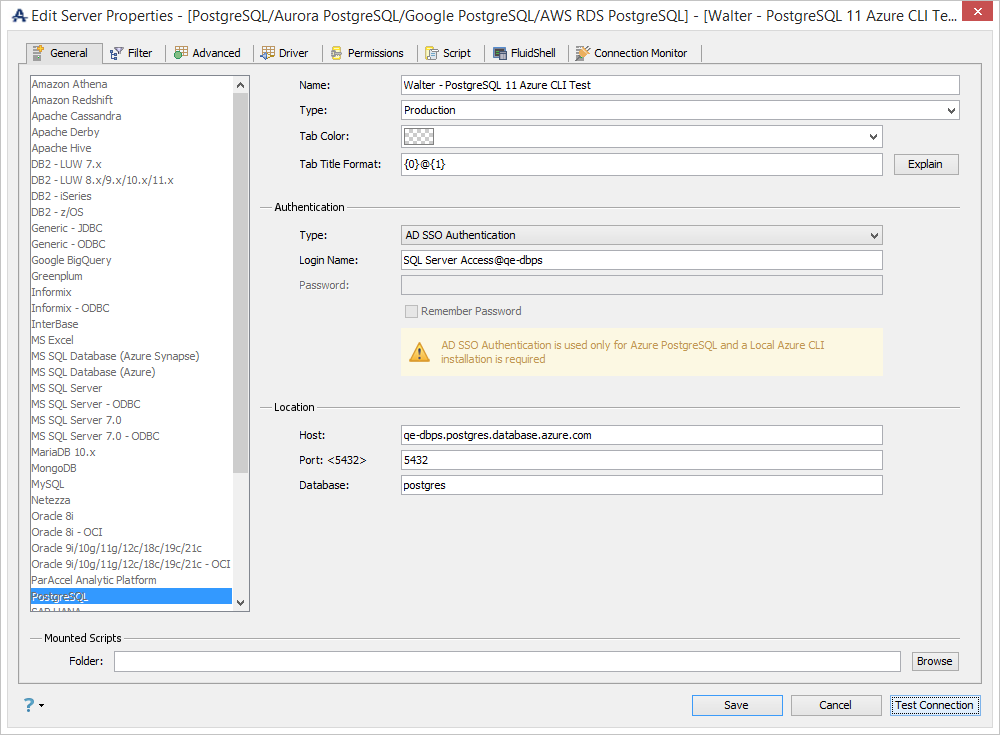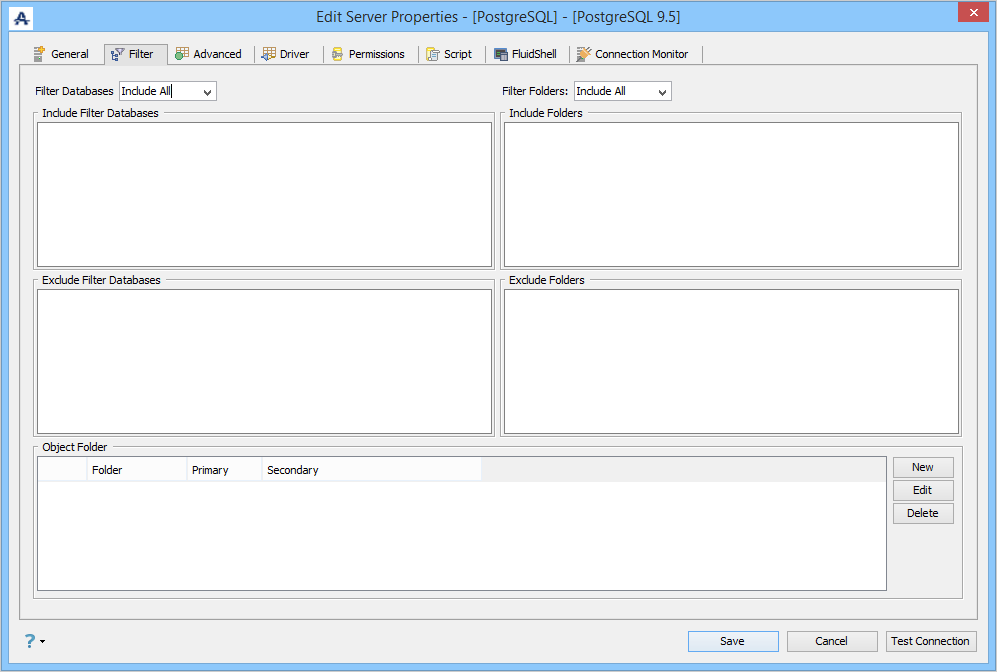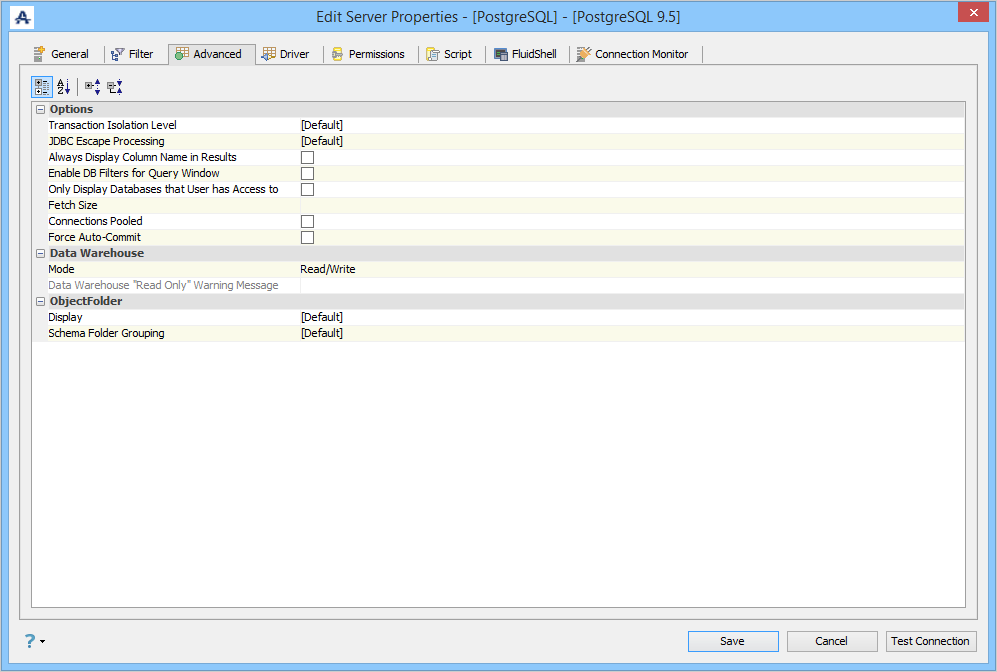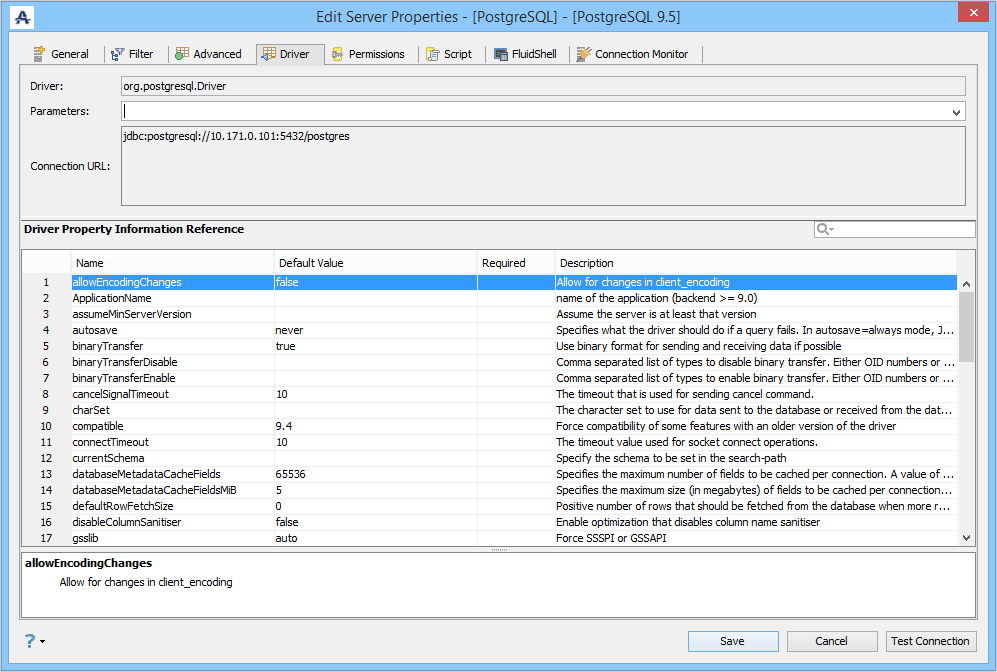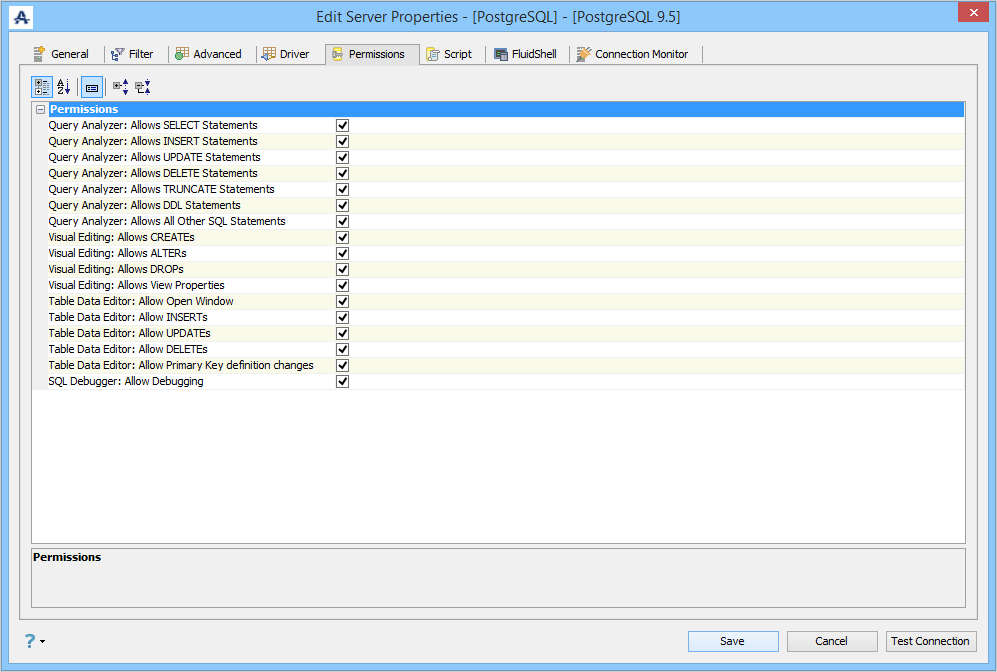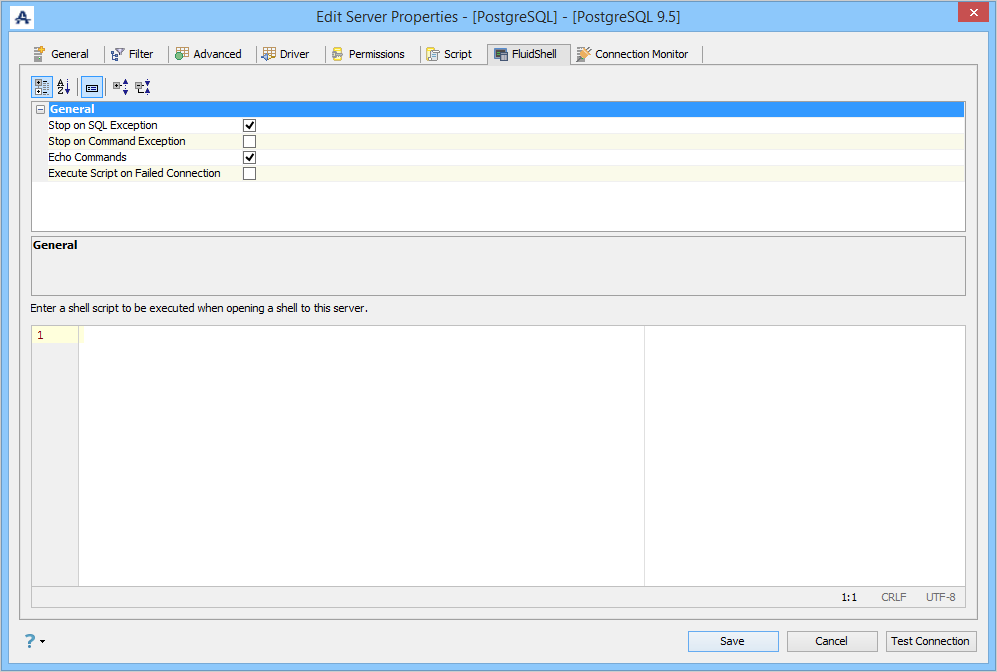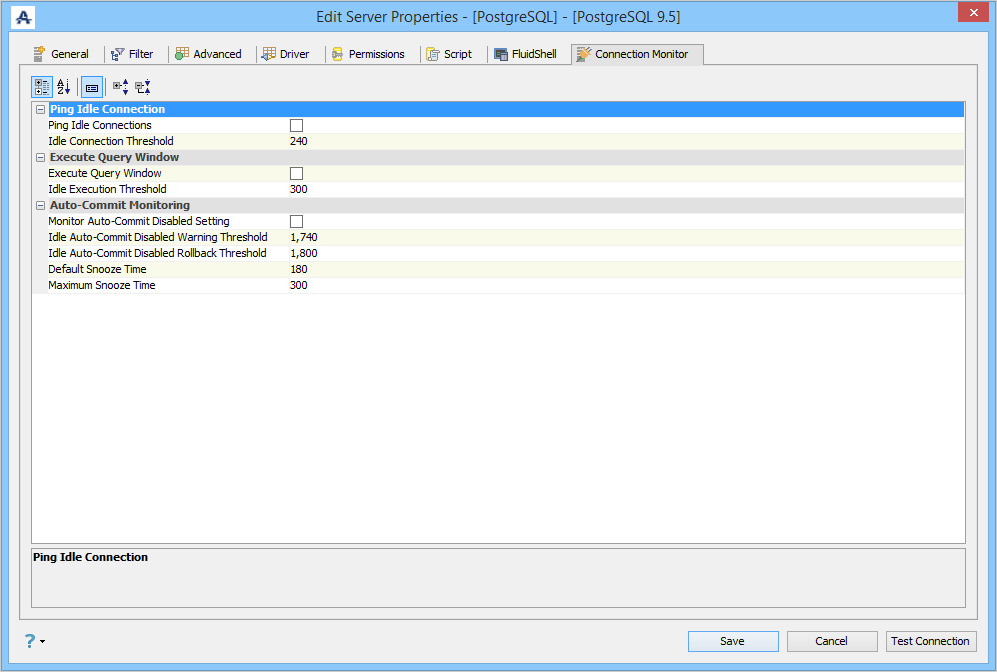If you have issues connecting to your PostgreSQL server, make sure that you have started your PostgreSQL postmaster with the ’-i’ option which enables TCP/IP connections.
General Tab
Tab Coloring
To Identify Server Environments, whether it is a Production, Development or Test, use the Tab Coloring feature:
- Locate the Server in the Server Browser.
- Right-click the Server - A Popup Menu Appears.
- Click the Item which displays Server Properties.
- Based on the Server Type, you can edit the Tab Coloring option to identify your environments.
In PostgreSQL you can choose to connect through either PostgreSQL Authentication or AD SSO Authentication. Click on the drop-down menu and choose the authentication method you prefer.
To use the AD SSO Authentication option make sure you have Azure CLI installed so you can set up the authentication.
- Azure CLI installation:
Download and install Azure CLI on your local machine. This is a required step, as Aqua Data Studio relies on Azure CLI to extract tokens for Azure PostgreSQL authentication.
Follow the intallation guide from the official Azure CLI documentation to complete this process. - Right-click on Azure Database.
- Select Server Properties.
- Under the Authentication section, select SSO Authentication and click Test Connection.
Using Filters Options in Registration (Filter Tab)
Edit the Server Properties, to use FILTER options for a Server in Aqua Data Studio:
- Locate the Server in the Server Browser
- Right-click the Server - A Popup Menu Appears
- Click the Item which displays Server Properties.
- Go to the Filter Tab and make changes in the Options.
- Filter Databases/Schemas: Allows the user to specify the main schema browser filter for databases or schemas, on whether to include or exclude all.
- Include Databases/Schemas: A list of databases/schemas to include after the main filter is applied.
- Exclude Databases/Schemas: A list of databases/schemas to exclude after the main filter is applied.
- Filter Objects: Allows the user to specify the main schema browser filter for object types, on whether to include or exclude all.
- Include Objects: A list of objects to include after the main filter is applied.
- Exclude Objects: A list of objects to exclude after the main filter is applied.
Features
- You can Create, Edit or Delete Object Folders. Default Folders are Tables, System Tables, Views, Indexes, Triggers, Procedures, Functions.
- Sometimes you would like to view only specific Schemas. Use options to INCLUDE or EXCLUDE all Schemas and Folders.
- Enter the Schema or Folder name in the specified text area and click OK. The current Connection will be terminated. Reconnect to see the changes.
- Filters are case-sensitive.
- Filter Databases works on the list of databases inside the "Databases" folder.
- Filter Folders works on the list of folders inside a particular database. Example folders: Tables, View, Procedures, etc.
- Object Folder filter works on individual folders inside a particular database. The user can define filters for each of the Tables, Views, etc. folders.
Filter Examples:
If your intention is to show only the tables that start with XXPKD, then you need to change your main filter to "Exclude All", and the secondary filter to "+XXPKD*". Note the "+" in front of the XXPKD pattern. Also, note that the filter pattern is case-sensitive.
The filter shown below is set to exclude all databases except those that start with "aq". This is similar to the above example where all schemas, except the XXPKD schema, are excluded. Then, there is an "Object Folder" filter on the Tables folder, which excludes everything except those that start with "forum".
Using Advanced Properties (Advanced Tab)
Edit the Server Properties to use Advanced Properties in Aqua Data Studio:
- Locate the Server in the Server Browser.
- Right-click the Server - A Popup Menu Appears.
- Click the Item which displays Server Properties.
- Go to the Advanced Tab and make changes in the Options.
With options in Advanced properties of a Server, you can:
- Change Transaction Isolation Modes.
- Enable Database Filters in Query Analyzer.
- Change Read Only / Read- Write Mode.
- Change Object Folder Display.
- Transaction Isolation Level: Support for setting Transaction Isolation Level.
- TRANSACTION_NONE - A constant indicating that transactions are not supported.
- TRANSACTION_READ_COMMITTED - A constant indicating that dirty reads are prevented; non-repeatable reads and phantom reads can occur.
- TRANSACTION_READ_UNCOMMITTED - A constant indicating that dirty reads, non-repeatable reads, and phantom reads can occur.
- TRANSACTION_REPEATABLE_READ - A constant indicating that dirty reads and non-repeatable reads are prevented; phantom reads can occur.
- TRANSACTION_SERIALIZABLE - A constant indicating that dirty reads, non-repeatable reads, and phantom reads are prevented. - JDBC Escape Processing: Allows JDBC driver to perform escape sequence before sending the SQL code to the server.
- Always Display Column Name in Results: Allows to show/hide column names in query results.
- Enable DB Filters for Query Window: Enables/Disables db filters for query windows using this connection.
- Only Display Databases that User has Access to: Displays only the databases the current user (from the Login Name on the General tab) has access to within the schema browser.
- Fetch Size: Determines the Fetch Size (number of rows physically retrieved from the database at one time by the JDBC driver).
- Connections Pooled: Enables connection pooling. Read more about connection pooling here.
- Force Auto-Commit: When this option is selected, it sets auto-commit to TRUE for any Query Window to this server and disables the icons on the toolbar, regardless of the option in File > Options > Query Analyzer > [DATABASE] > [Auto Commit].
- Data Warehouse Mode: Read Only or Read/Write.
- Object Folder Display: [Default], [Name], [Schema].[Name] or [Name]([Schema]) sets how the Schemas will be displayed.
- Object Folder Schema Folder Grouping: Default, Yes or No. Schema Folder Grouping makes finding tables much easier because it groups them instead of showing each object individually.
Using Driver Properties (Driver Tab)
Edit the Drivers Properties to use Driver Parameters in Aqua Data Studio:
- Locate the Server in the Server Browser.
- Right-click the Server - A Popup Menu Appears.
- Click the Item which displays Server Properties.
- Go to the Driver Tab and make changes in the Options.
With options in Driver properties of a Server, you can edit/view the:
- Driver: This displays the JDBC driver used for this connection.
- Driver Parameters: This option is to allow a user to specify extra JDBC parameters that a user might want to use in establishing a connection.
- Connection URL: This displays the connection URL for this server connection.
- Driver Parameters Quickfilter: This option is to allow a user to search JDBC parameters that a user might want to use in establishing a connection.
To use SSL in Aqua Data Studio, you must add the option"?ssl=true" in the "Driver Parameters:" in the Driver Tab of a Server Registration.
Registering Servers - PostgreSQL SSL
To enable SSL for PostgreSQL the user must import an SSLcertificate into the keystore of the Java Virtual Machine that is being used to run Aqua Data Studio.
Create a quick self-signed certificate using the following OpenSSLcommand:
openssl req -new -text -out server.req
Fill out the information that openssl asks for. The challengepassword can be left blank. The program will generate a key that ispassphrase protected; it will not accept a passphrase that is lessthan four characters long. To remove the passphrase (as you must ifyou want automatic start-up of the server), run the commands
openssl rsa -in privkey.pem -out server.key rm privkey.pem
Enter the old passphrase to unlock the existing key. Now execute the following
openssl req -x509 -in server.req -text -key server.key -out server.crt chmod og-rwx server.key
to turn the certificate into a self-signed certificate and copythe key and certificate to the data directory of the server. Nowconvert the server.crt to a format java can import on the client:
openssl x509 -in server.crt -out server.crt.der -outform der
Now import the cert into the java keystore:
keytool -keystore [your java home here]/lib/security/cacerts -alias [any name for cert desired] -import -file server.crt.der
Enter the password for the cacerts keystore (default is’changeit’). Say Yes to trust this cert.
Make sure your Aqua Data Studio instance knows which keystore touse for the SSL connection by adding to the startup script theparameter-Djavax.net.ssl.trustStore=\lib\security\cacerts
Windows: (Executable) - Modify the[ADS_INSTALL]\datastudio.ini
- Add to the file vmarg.2=-Djavax.net.ssl.trustStore=\lib\security\cacerts"
Windows: (Batch) - Modify the [ADS_INSTALL]\datastudio.bator datastudio-bundled.bat
- Last line should execute java with the parameter between"java" and "-cp" such as ...
"java -Djavax.net.ssl.trustStore=\lib\security\cacerts-cp"
OSX: - Modify /Aqua Data Studio/Contents/Info.plist
> ... > VMOptions > > -Djavax.net.ssl.trustStore=/Library/Java/Home/lib/security/cacerts > -Xmx256m > MainClass > com.aquafold.datastudio.DataStudio > ...
Unix: (Script)
- Last line should execute java with the parameter between"java" and "-cp" such as ...
"java -Djavax.net.ssl.trustStore=\lib\security\cacerts-cp"
Server Permissions (Permissions Tab)
Edit the Permissions in Server Properties in Aqua Data Studio:
- Locate the Server in the Server Browser.
- Right-click the Server - A Popup Menu Appears.
- Click the Item which displays Server Properties.
- Go to the Permissions Tab and make changes in the Options.
With options in the Permissions Tab of a Server, you can:
- Control Statement execution and Properties of the Query Analyzer, Table Data Editor, and Visual Editing.
- Grant / Revoke Permissions easily for executing DDL and DML Statements in the Query Analyzer.
- Change the behavior of the Table Data Editor for manipulating rows in Tables.
- Grant / Revoke Alters, Creates, Drops and View Properties of Visual Editing Tools.
Server Scripts (Script Tab)
Edit Scripts in Server Properties in Aqua Data Studio:
- Locate the Server in the Server Browser.
- Right-click the Server - A Popup Menu Appears.
- Click the Item which displays Server Properties.
- Go to the Script Tab and make changes in the Options.
With scripts in the Script Tab of a Server, you can:
- Enter an SQL Script that is executed each time a new connection is established.
- This allows the user to SET connection settings for a server connection. (eg: SET ROLE, ALTER SESSION SET XXX)
Shell Scripts (FluidShell Tab)
Edit Shell Scripts in Server Properties in Aqua Data Studio:
- Locate the Server in the Server Browser.
- Right-click the Server - A Popup Menu Appears.
- Click the Item which displays Server Properties.
- Go to the FluidShell Tab and make changes in the Options.
With scripts in the FluidShell Tab of a Server, you can:
- Enter a FluidShell Script that is executed each time a new FluidShell connection is established.
- This allows the user to cd (change directory) for a server connection. (eg: cd /scripts)
Server Connections (Connection Monitor Tab)
Enable the connection monitor to start an application thread that monitors the status of the connection associated with the Query Window.
With the connection monitor, you can:
- Set a ping operation that allows activity on the connection to prevent the connection from being terminated.
- Set an execute operation that executes the Query Window on a periodic basis.
- Set an auto-commit operation that checks how long the auto-commit has been disabled and whether the idle threshold has been exceeded. A warning threshold can also be configured so users can turn on auto-commit before it happens.
For more information, see Connection Monitor.
